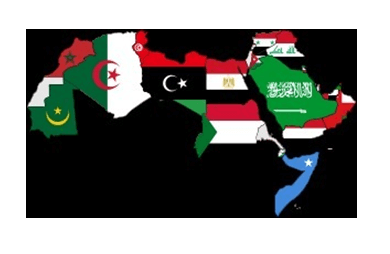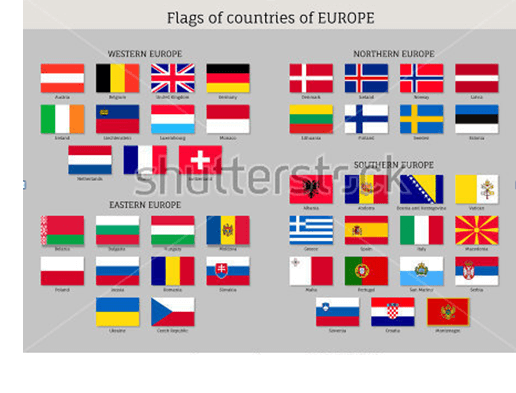History - Class 10
Our Past - I
Chapter 1: The Rise of Nationalism in Europe
The Rise of Nationalism in Europe is from NCERT text book class 10 history chapter 1. Here in this chapter, we will first start by discussing the introduction of the chapter, followed by The Rise of Nationalism in Europe class 10 questions and answers.
Introduction
To ensure that students do well on the CBSE Term I exams, NCERT has provided Solutions for Class 10 History Chapter 1 Rise of Nationalism in Europe. A nation's interests are promoted by nationalism, an ideology and movement, particularly with the goal of establishing and preserving the nation's sovereignty over its own territory. The idea of the nation-state is a relatively recent development as a result of the emergence of nationalism in Europe in the nineteenth century, prior to which there were no distinct nations in the world.
These NCERT Solutions for history class 10 chapter 1 - Rise of Nationalism in Europe will help the students to understand better and kow what the caricaturist is trying to depict in this chapter. It will improve their ability to answer all of the questions they are asked appropriately and precisely.
Activity: 1
Question 1: In what way do you think this print (Fig. 1) depicts a utopian vision?
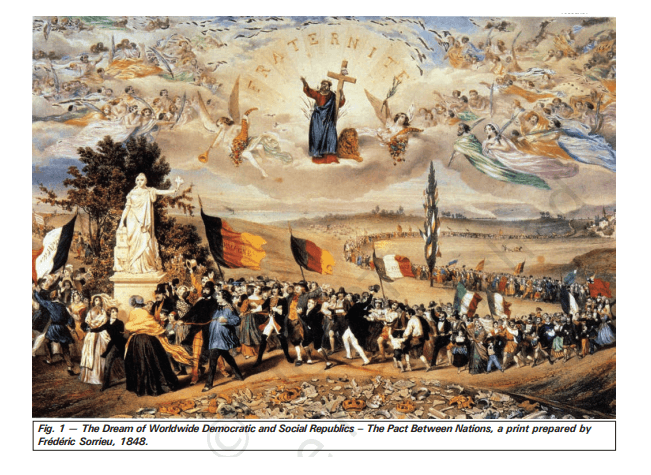
Answer: The print was a utopian vision coz:-
- All countries were together.
- The countries were supposed to be nation which didn't existed till then.
- Men, women and children were given equal status.
Discuss: 1
Question 2: Summarize the attributes of a nation, as Renan understands them. Why, in his view, are nations important?
Answer: Ernst Renan was a French philosopher who delivered a speech at the University of Sorbonne in 1882. In his speech he outlined the idea of what makes a nation. According to Renan, nations are formed by a common language, race, religion or territory. It is the culmination of a long past of endeavor, sacrifices and devotion. A nation does not take any interest in annexing or holding onto another Nation against its will.
Nations are important because their existence guarantee Liberty. The liberty of individuals would be lost if they are no nations
Discuss: 2
Question 3: Describe the political ends that List hopes to achieve through economic measures.
Answer: A customs union known as Wolverine was formed at the initiative of Prussia and joined by most of the German states. This union removed internal impediments and summed up 32 currencies into two. Besides this, it the aim of the union is to bind the Germans economically into a nation by strengthening the nation materially through its protection of interests externally and stimulating its internal production.
Activity: 2
Question 4: Plot on a map of Europe the changes drawn up by the Vienna Congress.
Answer: The Vienna Congress in 1815 changed the boundaries of Europe after the Napoleonic era. The boundaries were changed to make a strong France. Many countries opposed this, but it was remapped with Russia taking most parts of the Napoleonic under its control. The new states with new border were created although Europe with Switzerland being neutral territory. Although Napoleon escaped while in exile but was defeated in Waterloo.
Discuss: 3
Question 5: What is the caricaturist trying to depict?
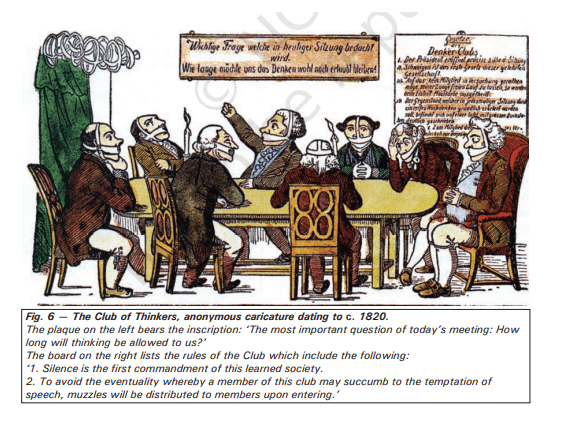
Answer: The caricaturist is depicting the club of liberal nationalists which dates back 1820. Conservative regimes were set up in 1815. These regimes were autocratic they were not ready to tolerate criticism and dissent. They curbed all the actions which put a question mark on the legitimacy of autocratic governments. Most of the regimes had imposed censorship law to have control over freedom of the press and over songs motivating the ideas of liberty.
Discuss: 4
Question 6: Discuss the importance of language and popular traditions in the creation of national identity.
Answer: A person is identified as belonging to a particular nation by his cultural traditions and the language that he speaks. The language as well as the traditional practices usually develop and get established over a long period of many hundreds of years.
They give an identity to an individual wherever he is. For instance, a Frenchman will normally speak the French language fluently. He will also follow French traditions and customs wherever he is in the world, as he would have imbibed them in his family from his childhood days. Thus, he will be identified as a French national.
Discuss: 5
Question 7: Describe the cause of the Silesian weavers’ uprising. Comment on the viewpoint of the journalist.
Answer: The cause of the Silesian weaver's uprising was the cheating of the weavers by the contractors. In 1845, the weavers raised a revolt against the contractors who used to supply them raw material to weave textiles in finished form. The contractors drastically reduced their payments. The viewpoint of the journalist Wilhelm Wolft for this uprising was as fellows- Weaver's crowd reached the house of the contractor and demanded higher wages.
They were not treated well, so a group of the crowd entered the contractors house forcibly and destroyed the furniture, window panes, plundered it. This shows that the viewpoint of the journalist was biased against the weavers and in favour of the contractor. On the other hand, the journalist did not understand the root cause of the uprising. He did not understand the poverty of weavers.
Activity: 3
Question 8: Imagine you are a weaver who saw the events as they unfolded. Write a report on what you saw.
Answer: I have worked very hard to supply the woven cloth in time, but received very little payment than what was agreed to by the contractor. Since, other weavers had also got less payment, on the afternoon of 4th June,
I went along with my partner and other weavers to the contractor’s house for asking for better wages for our weaving.
Our demands were scornfully refused and we were even threatened that no more work would be given to us if we did not work at the same rate as what was paid to us. Some of my fellow weavers got angry at this and broke the windowpanes of the contractor’s house, barged inside and damaged his furniture and crockery.
Some weavers also broke open his store of woven cloth and tore it all up. Seeing this, the contractor ran away from the house with his family to a nearby village, but there also he did not get shelter. Next day, the contractor returned with soldiers from the army, who fired at our group of weavers, killing eleven of us. I was injured in the leg by a bullet and now, I am nursing my wounds as I write this.Discuss: 6
Question 9: Compare the positions on the question of women’s rights voiced by the three writers cited above. What do they reveal about liberal ideology?
Answer: The liberal politician Carl Welcker, an elected member of the Frank furt Parliament, says that
- Woman is weaker than man and her sphere is the home where she keeps children and does household duties such as cooking, washing and cleaning, etc.
- Equality between the sexes or woman and man would only endanger harmony and destroy the dignity of the family.
According to Louise Otto-Peters, a political activist and founder of a woman's journal and a feminist political association, Men who try to gain freedom and liberty for all do not obey this but their untiring efforts are intended for the welfare of only men. She advocated that liberty cannot be divided among the men and women.
An Anonymous writer says that
- It is injustice to discriminate against women on the basis of gender.
- The women should not be deprived of the right to vote while an illiterate man has given the right to vote.
- The above discussion shows that Louise Otto-Peters and the Anonymous writer favor woman on the basis of rights of liberty and equality.
- The first writer does not favor woman's rights of liberty and equality.
Activity: 4
Question 10: Describe the caricature. How does it represent the relationship between Bismarck and the elected deputies of Parliament? What interpretation of democratic processes is the artist trying to convey?
Answer: The caricature depicts Bismarck, Chancellor of Germany as holding a whip (signifying that he is a ruthless man ruling with an iron hand) while leading the Parliament. The deputies who were elected are afraid of him and so are hiding under their tables. The caricature depicts the dominance of Bismarck over the deputies and how he despised liberalism and parliamentary assemblies. The artist is trying to convey that the democratic process in Germany was very shallow and the roots of constitutionalism were poor.
Activity: 5
Question 11: Look at Fig. 14(a). Do you think that the people living in any of these regions thought of themselves as Italians?
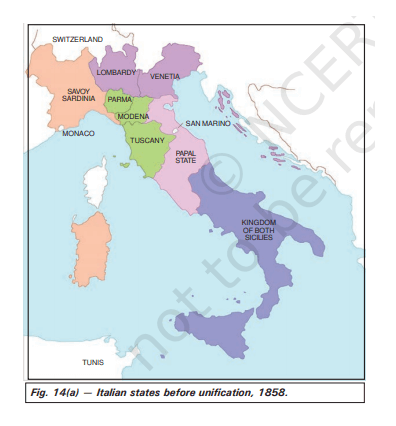
Answer: In 1858, Italy was divided into seven states, with the North being under the Austrian Habsburgs, the centre being ruled by the Pope and the Southern regions being under Spain's domination. Only one state, Sardinia-Piedmont was ruled by an Italian princely house. The Italian language also had not acquired a common form and had many regional and local variations. So people living in these regions, except Sardinia -Piedmont, would not have thought of themselves as Italians.
Question 12: Examine Fig. 14(b). Which was the first region to become a part of unified Italy? Which was the last region to join? In which year did the largest number of states join?
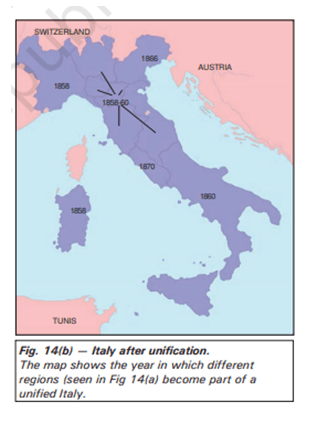
Answer:
- The first regions to become a part of unified Italy in 1858 were Savoy Sardinia followed by the Northern states.
- The last region to join was the Papal State in 1870.
- The largest number of states joined in 1860.
Activity: 6
Question 13: The artist has portrayed Garibaldi as holding on to the base of the boot, so that the King of Sardinia-Piedmont can enter it from the top. Look at the map of Italy once more. What statement is this caricature making?
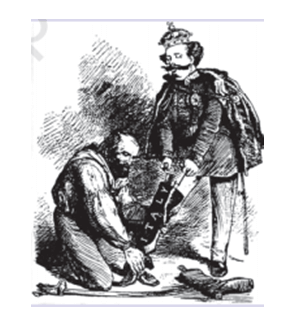
Answer: The base of the boot symbolizes the Kingdom of the Two Sicilians, which lay in the southernmost part of the Italian peninsula. Garibaldi had won this kingdom and handed it over to King Victor Emmanuel II. This cartoon signifies the unification of Italy and Garibaldi's role in it.
Activity: 7
Question 14: With the help of the chart in Box 3, identify the attributes of Veit’s Germania and interpret the symbolic meaning of the painting. In an earlier allegorical rendering of 1836, Veit had portrayed the Kaiser’s crown at the place where he has now located the broken chain. Explain the significance of this change.
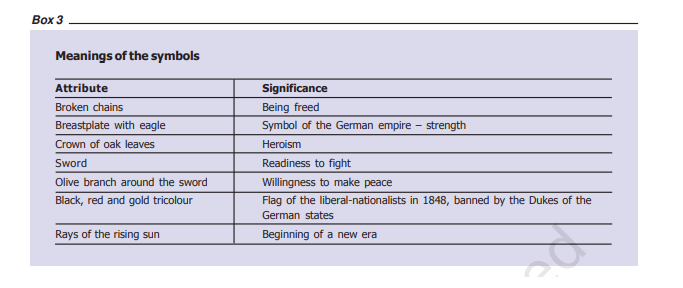
Answer: The symbolic meaning of the painting is that the German nation has emerged. The female figure of Germania is an allegory of the German nation. All the attributes of the German nation out be seen in the painting as given in the chart. The replacement of the Kaiser’s crown with the broken chain signifies that the German nation is now free from autocratic monarchical rule.
Activity: 8
Question 15: Describe what you see in Fig. 17. What historical events could Hübner be referring to in this allegorical vision of the nation?
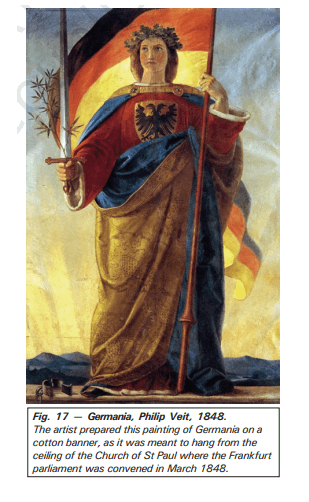
Answer: Julius Hübner painted this picture of Germania, allegory of the German -nation, in 1850, 2 years after the national assembly at Frankfurt was rejected by the monarchs. In the foreground of the picture, there are symbols of absolutism and Germania lies before it. This shows that the united hope if German becoming a nation is now shriveled. And the entire nation falls down before the monarchy.
Thus, the Frankfurt parliament being forced to disband, by the monarchs, was the event Hübner is referring to in his painting.
Activity: 9
Question 16: Look once more at Fig. 10. Imagine you were a citizen of Frankfurt in March 1848 and were present during the proceedings of the parliament. How would you
- As a man seated in the hall of deputies, and
- As a woman observing from the galleries, relate to the banner of Germania hanging from the ceiling?
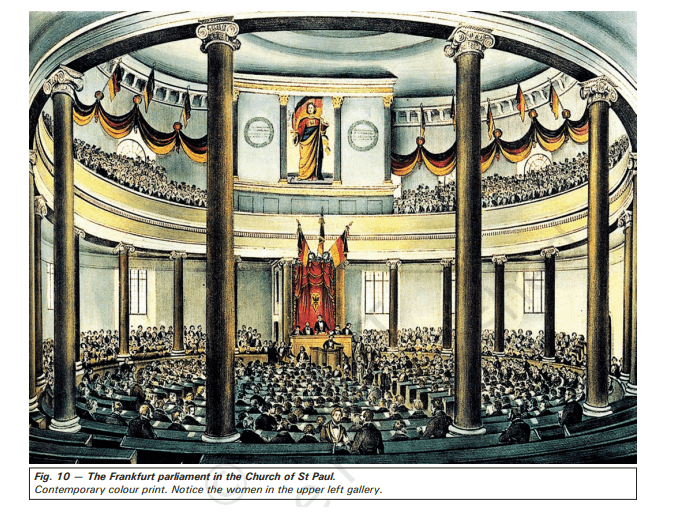
Answer:
- As a man seated in the hall of deputies, I would relate positively to the banner of Germania, as I would feel all that it symbolized was coming true.
- As a woman observing from the galleries, I would consider the banner to depict the truth only partially Women had participated with men equally in the struggle for constitutionalism with national unification, but they were denied suffrage rights during elections to the National Assembly, Women were only admitted to the assembly as passive citizens and observers.
Write in brief
Question 17: Write a note on:
- Giuseppe Mazzini
- Count Camillo de Cavour
- The Greek war of independence
- Frankfurt Parliament
- The role of women in nationalist struggles.
Answer:
- Giuseppe Mazzin:
Giuseppe Mazzini was born in Genoa in 1807, and he became a member of the secret society of the Carbonari. As a young man of 24, he was sent into exile in 1831 for attempting a revolution in Liguria. He subsequently founded two more underground societies, first, Young Italy in Marseilles, and then, Young Europe in Berne, whose members were like-minded young men from Poland, France, Italy and the German states. Mazzini believed that God had intended nations to be the natural units of mankind.
- Count Camillo de Cavour:
Chief Minister Cavour who led the movement to unify the regions of Italy was neither a revolutionary nor a democrat. Like many other wealthy and educated members of the Italian elite, he spoke French much better than he did Italian. Through a tactful diplomatic alliance with France engineered by Cavour, Sardinia-Piedmont succeeded in defeating the Austrian forces in 1859. Apart from regular troops, a large number of armed volunteers under the leadership of Giuseppe Garibaldi joined the fray.
- The Greek war of independence:
An event that mobilised nationalist feelings among the educated elite across Europe was the Greek war of independence. Greece had been part of the Ottoman Empire since the fifteenth century. The growth of revolutionary nationalism in Europe sparked off a struggle for independence amongst the Greeks which began in 1821. Nationalists in Greece got support from other Greeks living in exile and also from many West Europeans who had sympathies for ancient Greek culture.
- Frankfurt Parliament:
In the German regions a large number of political associations whose members were middle-class professionals, businessmen and prosperous artisans came together in the city of Frankfurt and decided to vote for an all-German National Assembly. On 18 May 1848, 831 elected representatives marched in a festive procession to take their places in the Frankfurt parliament convened in the Church of St Paul. They drafted a constitution for the German nation to be headed by a monarchy subject to a parliament. When the deputies offered the crown on these terms to Friedrich Wilhelm IV, King of Prussia, he rejected it and joined other monarchs to oppose the elected assembly.
- The role of women in nationalist struggles:
- Artistic representations of the French Revolution show men and women participating equally in the movement.
- Liberty is personified as the women.
- Liberal nationalism propounded the idea of universal suffrage, leading to women’s active participation in nationalist movements in Europe.
- Women had formed their own political associations, founded newspapers.
- They had taken part in political meetings and demonstrations.
- In France about sixty women’s clubs came up in different French cities.
- The most famous was the society of Revolutionary and Republican women.
- One of their main demands was to have same political rights as men had. They were, however, denied suffrage rights during the election to the Assembly.
- Although women had actively participated in nationalist struggles, they were given little or no political rights, an example being the Frankfurt Parliament in the Church of St. Paul where women were admitted only as observers to stand in the visitors’ gallery.
Question 18: What steps did the French revolutionaries take to create a sense of collective identity among the French people?
Answer: The following steps were taken by the French revolutionaries to create a sense of collective identity among the French people:
- The ideas of the fatherland (la patrie) and the citizen (le citoyen) were introduced.
- A new French flag, the tricolour, was chosen to replace the earlier royal standard.
- The Estates General was renamed as National Assembly.
- New hymns were composed, oaths were taken and martyrs commemorated, all in the name of the nation.
- A centralised administrative system was established.
- Uniform laws for all citizens were formulated.
- Internal custom duties and dues were abolished.
- A uniform system of weights and measures was adopted.
- French, as it was written and spoken in Paris, became the common language of the nation. Regional dialects were discouraged.
- It was decided that the French nation would liberate the peoples of Europe from despotism, and help other peoples to become nations.
Question 19: Who were Marianne and Germania? What was the importance of the way in which they were portrayed?
Answer: Female allegories were invented by artists in the nineteenth century to represent the nation. In France, she was christened Marianne, a popular Christian name, which underlined the idea of a people’s nation. Her characteristics were drawn from those of Liberty and the Republic – the red cap, the tricolour, the cockade. Statues of Marianne were erected in public squares to remind the public of the national symbol of unity and to persuade them to identify with it. Marianne images were marked on coins and stamps.
Similarly, Germania became the allegory of the German nation. In visual representations, Germania wears a crown of oak leaves, as the German oak stands for heroism.
Question 20: Briefly trace the process of German unification.
Answer: After 1848, nationalism in Europe moved away from an association with democracy and revolution. Nationalist sentiments were often mobilized by conservatives for promoting state power and achieving political domination over Europe. Thus, Germany and Italy were unified as nation-states as mentioned below:
- Napoleon’s administrative measures had created out of countless principalities a confederation of 39 states. Each of these possessed its own currency and weights and measures.
Such conditions were obstacles to economic exchange and growth by the new commercial classes. - In 1834, a customs union or Zollvere it was established. It allowed free trade among its members. It created a real national unity in economic matters, at a time when Germany was politically not united. A wave of economic nationalism strengthened the wider nationalist sentiments.
- As a result of 1848 revolution in France, in Germany where a nation state did not exist the men and women of the liberal middle classes raised the demands for constitutionalism and national unification.
- In May 1848, a large number of political associations decided to vote for an all-German National Assembly at Frankfurt and drafted a constitution for a German Nation to be headed by a monarchy subject to a parliament. The offer was made to Prussian King but it was rejected by him. Thus, the liberal initiative to nation building failed.
- Thereafter the task of unification of Germany was taken over by Prussia and its chief minister, Otto von Bismarck who was architect of modern Germany.
- Bismarck followed a policy of‘blood and iron’. He carried out his plans with the help of the Prussian army and bureaucracy.
- In 1862, Bismarck reorganised the Prussion army and improved training in war. In 1864 he constructed an alliance with Austria to fight Denmark over Denmark’s southern provinces of Schleiswig while Austria administered Holstein. Bismarck provoked a conflict with Austria over an unrelated border dispute and in the subsequent Seven Weeks War, Prussia defeated Austria. The peace treaty transferred Holstein to Prussia and forced Austria to officially remove itself from all German affairs.
- Next was war with France. In 1870, Bismarck forged a note from the French ambassador, implying that the ambassador had insulted the Prussian King. After he leaked this letter to both populations, there was a cry for war. At this stage, the southern provinces rallied to Prussia’s side. In 1870 France declared war on Prussia but was defeated. As a result of war, Alsace Lorraine was transferred to Germany.
- Ultimately in January 1871, in the Hall of Mirrors at the Palace of Versailles, The Prussian King William I was proclaimed German Emperor. Thus, unification of Germany was completed. This demonstrated the dominance of Prussian state power. It was victory of Bismarck’s policy of ‘blood and iron’ and it tended to foster militarism and authoritarianism in Germany.The new state placed a strong emphasis on modernising the currency, banking, legal and judicial systems in Germany. Prussian measures and practices often became a model for the rest of Germany.
Question 21: What changes did Napoleon introduce to make the administrative system more efficient in the territories ruled by him?
Answer: Within the wide area of territory that came under his control, Napoleon set about introducing many of the reforms that he had already introduced in France. Through a return to monarchy Napoleon had, no doubt, destroyed democracy in France, but in the administrative field he had incorporated revolutionary principles in order to make the whole system more rational and efficient.
The Civil Code of 1804 – usually known as the Napoleonic Code – did away with all privileges based on birth, established equality before the law and secured the right to property. This Code was exported to the regions under French control. In the Dutch Republic, in Switzerland, in Italy and Germany, Napoleon simplified administrative divisions, abolished the feudal system and freed peasants from serfdom and manorial dues. In the towns too, guild restrictions were removed. Transport and communication systems were improved. Peasants, artisans, workers and new businessmen enjoyed new-found freedom.
Businessmen and small-scale producers of goods, in particular, began to realize that uniform law, standardized weights and measures, and a common national currency would facilitate the movement and exchange of goods and capital from one region to another.Discuss
Question 22: Explain what is meant by the 1848 revolution of the liberals. What were the political, social and economic ideas supported by the liberals?
Answer: The 1848 revolution of the liberals mean the revolution led by the educated middle classes of Europe. Events of February 1848, in France brought about the abdication of the monarchy and a republic based on universal male franchise was formed. In Europe, the educated middle class made up of industrialists, businessmen and professionals played a lead role in nationalist movement. They were imbibed by liberal ideas and socially, demanded freedom of individuals, freedom of press and equality of all before law.
Politically, they emphasized the concept of government by consent. Since the French Revolution, these revolutionaries stood for the end of autocracy and clerical privileges and emphasized a constitution and representative government through parliament. They also stressed the inviolability of private property. In . the economic sphere, they stood for the freedom of markets and the abolition of state-imposed restrictions on trade.
Question 23: Choose three examples to show the contribution of culture to the growth of nationalism in Europe.
Answer: In Europe, culture made significant contribution in strengthening nationalistic feelings.
- Romanticism was a cultural movement, which sought to develop a particular form of nationalist sentiment. Criticizing the glorification of reason and science, it made effort to create a sense of ashared collective heritage, a common cultural past as the basis of a nation.
- Folk culture such as folk songs, folk poetry and folk dances popularized the true spirit of the nation and united common people.
- Language too played an important role in developing nationalist sentiments. After Russian occupation, the Polish language was forced out of schools and the Russian language was imposed everywhere. A large number of priests and bishops, however, used Polish for church gatherings and all religious instructions. So, they were put in jail or sent to Siberia by the Russian authorities as punishment. Thus, the use of Polish came to be seen as a symbol of the struggle against Russian dominance. The emphasis on vernacular language and the collection of local folklore was not just to recover an ancient national spirit, but also to carry the modern nationalist message to large audience who were mostly illiterate.
Question 24: Through a focus on any two countries, explain how nations developed over the nineteenth century.
Answer: Italy:
The dedication, contribution and effort of the three great leaders: Mazzini, Cavour and Garibaldi helped in the unification of Italy. Italy had a long history of political fragmentation. Italians were scattered over several dynastic states as well as the multinational Habsburg Empire. During the middle of the nineteenth century, Italy was divided into seven states, of which only one, Sardinia-Piedmont, was ruled by an Italian princely house.
The north was under Austrian Habsburgs, the centre was ruled by the pope and the southern regions were under the domination of Bourbon Kings of Spain. During the 1830s, Giuseppe Mazzini sought to put together a program for a unitary Italian Republic. He also formed a secret society called Young Italy for the dissemination of his goals. The failure of revolutionary uprisings both in 1831 and 1848 meant that unification of Italy could be possible through war under the king Victor Emmanuel II.Victor Emmanuel’s chief minister Cavour supported him wholeheartedly in this task. He was neither a revolutionary nor a democrat but he led the movement to unify the Italian regions.
He made a tactical diplomatic alliance with France and succeeded in defeating the Austrian forces in 1859. Apart from regular troops a large number of armed volunteers under the leadership of Garibaldi joined the fray. In 1860, they marched into South Italy and the Kingdom of the Two Siciles, and succeeded in winning the support of the local peasantry in order to drive out the Spanish rulers. Finally, in 1861king Emmanuel II was proclaimed king of united Italy.
Germany:
The Frankfurt Parliament tried its best for the unification of Germany under the leadership of King Wilhelm IV of Prussia but it failed and made it clear that German unification had to come through combined effort of monarchy and military supported by large landowners of Prussia. From then on, Prussia took on the leadership of the movement for national unification. Otto von Bismarck, the Chief Minister of Prussia, was the architect of this process.
He wanted to achieve his aim by expanding Prussia into Germany. He reached his goal with the help of Prussian army and the bureaucracy. Bismarck fought three wars over seven years with Austria, Denmark and France which ended in Prussian victory and completed the process of unification.
On January 18, 1871, an assembly comprising the princes of the German states, representatives of the army, important Prussian ministers including the Chief Minister Otto von Bismarck gathered in the unheated Hall of Mirrors in the Palace of Verailles to proclaim the new German Empire headed by Kaisar William I of Prussia.Question 25: How was the history of nationalism in Britain unlike the rest of Europe?
Answer:
- In Britain, the formation of the nation-state was not the result of a sudden upheaval or revolution.
- There was no British nation prior to the eighteenth century. The primary identities of the people who inhabited the British Isles were ethnic ones such as English, Welsh, Scot or Irish.
- All of these ethnic groups had their own cultural and political traditions. But as the English nation steadily grew in wealth, importance and power, it was able to extend its influence over the other nations of the islands.
- In 1688, the English parliament seized power from the monarchy and became the instrument through which a nation state, with England at its centre, came to be forged.
- The Act of Union [1707) between England and Scotland resulted in the formation of the ‘United Kingdom of Great Britain’.
- Though the Irish Catholics were against a union with England as the English helped the protestants of Ireland to establish their dominance over a largely Catholic country, Ireland was forcibly incorporated into the United Kingdom in 1801.
Thus, the emergence of United Kingdom as a strong and democratic state was the result of a parliamentary action and not of a revolution or war.
Question 26: Why did nationalist tensions emerge in the Balkans?
Answer: Though all countries accepted the idea of nation-states as natural and universal, the people everywhere developed their own specific variety of nationalism.
The Balkans was the most serious source of nationalist tension in Europe. It presents a unique example of how the rebellious nationalists struggled to win back their long- lost independence.
The Balkans was a region of geographical and ethnic variations comprising modern-day Romania, Bulgaria, Albania, Greece, Macedonia, Croatica, Bosnia-Herzegovina, Slovenia, Serbia and Montenegro. The inhabitants belonged to the ethnic group were broadly known as the Slavs. A large part of the Balkans had been under the rule of Ottoman Empire since long. Due to the strategic position of the Balkan region, imperial powers of Europe wanted to extend their control over the region.
So they competed with one another that resulted in intense conflict among these powers. The domination of other powers separated the people of the Balkans from each other who belonged to one ethnic group. The spread of the ideas of romantic nationalism in the Balkans together with the disintegration of the Ottoman Empire made this region very explosive. The Balkan region, thus, became an area of intense conflicts leading to a series of wars in the region and finally the First World War.Project
Question 27: Find out more about nationalist symbols in countries outside Europe. For one or two countries, collect examples of pictures, posters or music that are symbols of nationalism. How are these different from European examples?
Answer: Some of the nationalist symbols of the countries other than European countries are as under:
| S.No. | National Symbols | America | Russia | China | India |
| 1. | Flag | 50 stars on blue color background surrounded by red and white strips | 3 horizontal strips of white, blue and red color | Red flag with one big and five small yellow color stars | 3 strips of orange, white and green color with chakra in the middle (white) strip. |
| 2. | Bird Eagle | Bald Eagle | Double head(Bice phallic) Eagle | Chinese Dragon | Peacock |
| 3. | Flower | The Rose | Camomile(sun flower variety) | Peony | The Lotus |
| 4. | Anthem | The star spangled banner by Francis Scott Key | Hymn of Russian Federation by Sergey Mikhalkov | The March of Volunteers | Jana, Gana, Mana by Rabindra Nath Tagore |
| 5. | Music Patriotic | God Bless America by Irving Berlin | Grom pobedy, raz davaysay! by Gatril Derzhavin |
|
Vande Mataram by Bankin Chandra Chattopadhyay |
These nationalist symbols are very different from the symbols of European countries in the manner that they manifest nationalist sentiments of their respective countries.
Images showing the difference between the flag of Europeans and others:
